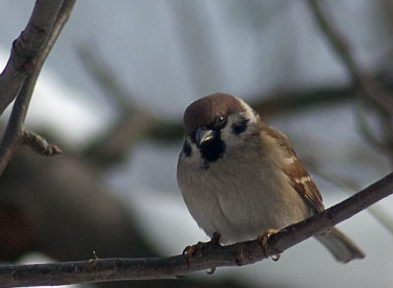Tree Sparrow (Passer montanus) - Wiki Tree Sparrow
From Wikipedia, the free encyclopedia
[Photo] Tree Sparrow (Passer montanus). Photo taken in Rumia, Poland by Adam Kumiszcza.
The Tree Sparrow, Passer montanus, is spread over most of Europe and Siberia, and allied forms occur in other parts of Asia. It has been introduced to Australia. In the United States (where it is known as the Eurasian Tree Sparrow to differentiate it from the native, unrelated American Tree Sparrow), German immigrants introduced it to the area around St. Louis in the 1870s. From there, it has slowly expanded its range into Illinois and Missouri. Changes in farming methods have meant that species is declining in some parts of western Europe.
This 12.5???14 cm long bird is often confused with the larger House Sparrow, but its rich brown, almost coppery head, a black patch on its white cheeks, and a double white wing bar, together its slighter and more graceful build, are distinctive. The sexes are practically alike, an important specific character.
The crown and nape are rich chestnut, and on the white cheeks and ear-coverts there is a triangular black patch; the chin and throat are black. Two distinct though narrow white bars cross the brown wings. In summer the bill is lead-blue, in winter almost black. The legs are pale brown and the irides hazel.
Young, even in the nest, closely resemble their parents. They are said to be duller, and in the depicted young bird the face pattern is blurred. The breast and belly are browner.
The Tree Sparrow is rural in Europe, but replaces its relative as a town bird in parts of Asia. It used to be considered as the national bird of the Philippines, and locally called maya. In Australia, it is found in some rural and semi-rural districts, but not cities. The small American population is sometimes referred to as "German Sparrows", to distinguish it from the native species as well as the vast numbers of "English" House Sparrows.
Its voice is more shrill; the call is a shorter chip, than the House Sparrow's and the song, consisting of modulated chirps, is musical.
Though occasionally nesting in isolated trees, it is a gregarious bird at all seasons, and a grove of old trees with a plentiful supply of hollows, or a disused quarry, are favourite sites for the colony ; what it likes is a hole in which to put its untidy nest, composed of hay, grass, wool or other material and lined with feathers.
Some of the nests are not actually in holes in rock, but are built among roots of overhanging furze or other bushes. The haunts of man are not always shunned, for old thatch in a barn or cottage will shelter a colony. A domed nest, like that of the House Sparrow, is sometimes built in the old nest of a Magpie or other bird.
The four to six eggs, usually five, are smaller and, as a rule, browner than those of the House Sparrow. They vary considerably, and frequently the markings are massed at one end. In most clutches one egg is lighter and differs in markings from the others.
http://en.wikipedia.org/wiki/Tree_Sparrow
| The text in this page is based on the copyrighted Wikipedia article shown in above URL. It is used under the GNU Free Documentation License. You may redistribute it, verbatim or modified, providing that you comply with the terms of the GFDL. |
